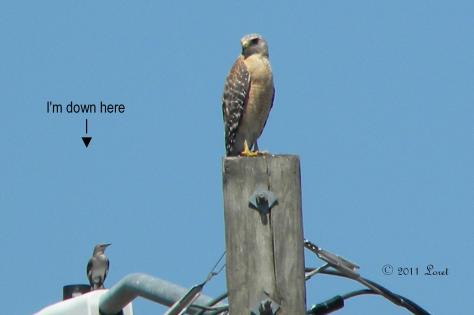Dateline: February 8, 2013*

The war of spring has started. It’s the Northern Mockingbirds (Mimus polyglottos) vs. the cardinals, bluebirds and ME! While no other bird can match their beautiful song repertoire, the ugly squawk and dive at my precious bluebirds is really rubbing me the wrong way. Oh, and the other day when they took a shot at my head. The bullies of the bird world.

The mockingbird has an “amazing ability to mimic other bird songs and sounds, its scientific name polyglottos – “many tongued” – is very apt.” You might even think there are several species of birds visiting only to discover just one bird with a language ability that would make him tops at the Birdy United Nations. They sing all day and sometimes at night. As they age their vocabulary can increase. During the eighteen-hundreds their numbers were in jeopardy as they were a commodity bought and sold. People caged them as house pets to enjoy their melody.

According to whatbird.com:
A group of mockingbirds has many collective nouns, including an “echo”, “exactness”, “plagiary”, and a “ridicule” of mockingbirds.
And, they have been known to “ridicule” ME!

Mockingbirds aggressively defend “their” territory. Well, I’ve got news for them, this is MY territory and I’ll not have them starting nests where they will chase away the bluebirds. Bluebirds nest only in boxes or cavities whereas mockingbirds nest just about anywhere shrubby that will hold their assortment of twigs, dryer lint and cigarette butts.

The males start the nest building in several areas, then the females choose which nest they like and put on the finishing touches. Baccharis halimifolia, Wax Myrtle, oak and holly are some of the shrubbery they have chosen to build at my place. And build they do. I’ve had numerous successful broods of Mockingbirds and also some tragedies…4 eggs one day…none the next.

They like an open lawn (I think for a clear shot at me), shrubs to hide in and tall trees to perch for a “bird’s eye view”.

As with most birds, the mockingbird’s primary diet during nesting season and summer consists of insects. They aren’t fussy, eating beetles, earthworms, moths, butterflies, ants, bees, wasps, and grasshoppers. Apparently they also will eat small lizards to round out their menu. They are big fruit eaters come fall and winter.

Some of their favorite eats in my yard consist of native plants: dahoon berries, beautyberry, winged sumac drupes, grapes, blackberries and gallberries. Other choices would include mulberries and hawthorns.

So, while not my favorite bird, I listen to the songs of the Mockingbirds and think that maybe they aren’t so bad. They certainly can bring a sound of joy to nature like no other creature.

*This tale was originally published by Loret T. Setters on February 8, 2013 at the defunct national blog beautifulwildlifegarden[dot]com. Click the date to view reader comments.

6 thoughts on “Mockingbird: Melodious but Mean”